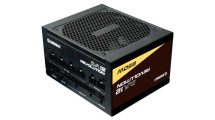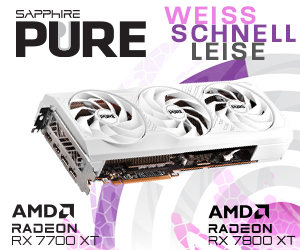Step 1 – Sequential performance of the used SSDs
If you compare some reviews that seem to have tested almost exclusively with new goods, then the used and data-filled SSDs fall a bit, but not strongly. The CrystalDiskMark is the typical classic there, which also does not even really scratch the pseudo-SLC cache. As such, this is more for the gallery and smaller amounts of data written at a time. Both the Corsair and Patriot SSDs perform very similarly here. The read rate is slightly lower, but the write rate is slightly higher than the Patriot VP4100 and about the same as the results of the Corsair MP600.
ATTO is a bit more demanding, but even here the test is not enough to bring the pSLC cache to its knees. On the other hand, reading is now a lot faster, while writing is slightly slower.
Step 2 – Real-World Scenarios and Endurance Test
Just the daily use of the SSDs also corresponds approximately to what the SPECwpc there on the drives loslässt, because I work with the same or similar applications. Sometimes you notice the value of a very fast SSD, but often you don’t. It’s enough to use a normal NVMe, no matter if PCIe Gen. 4 or 3. Do it as it may, because just the large pSLC cache helps the tested SSDs to almost the same extent.
But before I evaluate the SPECwpc, let’s take a look at AJA, because this is where we need to see how far the pSLC cache goes. Unfortunately, AJA doesn’t run for 3 minutes, because only then did a video stream that was only slightly compressed break down a bit for me. This time to pSLC cache collapse was also roughly identical for all three SSDs. Now let’s look at writing first:
Now how does that look when reading the stream? Not bad when you look at the curve, and it’s even more balanced than the Patriot Viper VP4100.
This brings us to SPECwpc and the real-world applications it contains. I’ll pass on the IOPS and rather stick to the write and read rates in MB/s. Because what is generally written here is small but common, which can also be seen in the low rates. There you are far away from the theoretically possible maximum rates and what you can manage in a constant stream. Let’s first look at the read processes and see that both SSDs are very close to each other and only differ slightly in the application results.
When it comes to writing, both SSDs are virtually on par. The Corsair Force MP600 is at a bit of a disadvantage with larger blocks, but scores well with smaller blocks. Overall, though, it all balances out nicely. The performance to the Patriot Viper VP4100 would be even more similar, by the way, so I preferred to go with the Corsair model for the charts.
Summary and conclusion
If several SSDs with identical PCB and component placement meet, there are certainly slight tolerances in the NAND, but this is in the negligible range. The only difference I could notice at all is a slight advantage in write rates with the firmware. PNY seems to have optimized something in the direction of larger streams. For that, the PNY XLR8 CS3040 NVMe M.2 SSD 1 TB lacks the hardware-accelerated AES 256-bit encryption that Corsair offers. Those who can do without it will get an SSD that is often slightly faster, at least in benchmarks.
SSD prices are daily prices and they also fluctuate quite decently. As such, the few sellers of the PNY XLR8 CS3040 NVMe M.2 SSD 1 TB are at a slight disadvantage, as apart from Amazon, only Proshop offers this SSD, albeit at a much higher price of over 200 Euros. Those who appreciate the service of Amazon Prime can almost grab it here without thinking, because the handling and delivery is also better than the similarly priced competitor products in the Mindfactory online shop.
All in all, these are almost premium products that you should buy not only because of the PCIe 4.0 support, but because the pseudo-SLC cache is so big that you really need minutes to bring it to its knees. That’s saying something, even if it’s not impossible. But who records RAW streams in Ultra HD? But that’s not quite so far-fetched either. What else? The cooler rips it out again in the end and not off, because sliders and heat conduction pads are always better than permanent glue. Also for the RMA.






































22 Antworten
Kommentar
Lade neue Kommentare
Veteran
1
Urgestein
Veteran
Neuling
Mitglied
Mitglied
Mitglied
Urgestein
Mitglied
Mitglied
Mitglied
Veteran
Mitglied
Mitglied
Mitglied
Mitglied
Urgestein
Mitglied
Alle Kommentare lesen unter igor´sLAB Community →